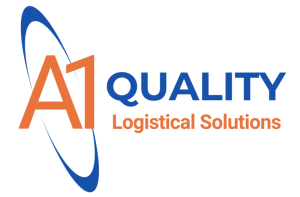A1 Quality Logistical Solutions

- By Haley
- July 22, 2025
Table of Contents
Key Highlights
- Third-party logistics (3PL) providers offer comprehensive logistics services, including transportation, warehousing, and distribution, tailored to streamline supply chain operations.
- By outsourcing logistics, businesses see reduced costs in shipping, labor, and capital expenditure and improved supply chain efficiency.
- Advanced 3PL capabilities, such as distributed warehousing and real-time data analytics, strategically optimize logistics activities and boost profit margins.
- 3PL services contribute to enhanced customer satisfaction through faster shipping options and omnichannel fulfilment solutions.
- Choosing the right 3PL partner can drive business growth and higher returns on investment.
Introduction
Are you seeing your profit margins go down in the supply chain? Third-party logistics (3PL) providers might be what you need. These experts in logistics services know how to handle the many moving parts of a supply chain. They can also help you find new ways to earn more money. When you use third-party logistics, your business can work better, spend less on logistics, and keep customers happy. Many companies see how much 3PL can help with profit in the long run. In this blog, we will talk about how third-party logistics can help you earn more and why this way of working matters so much for supply chains today.
The Role of 3PL in Modern Supply Chains
Third-party logistics (3PL) companies are an important part of supply chain management today. They help with many jobs like transportation and distribution services. 3PLs help make logistics operations better and bigger. Their skills let a business improve supply chain tasks and still keep working well on what it does best.
Also, 3PL providers connect businesses with the needs of today’s customers, especially in retail and online shopping. They help make deliveries faster, improve inventory, and make sure orders are sent out smoothly. Their work keeps changing how supply chains compete in different industries.

Defining Third-Party Logistics (3PL)
Third-party logistics, or 3PL, is when a business uses outside companies for their logistics services. These companies, called logistics service providers, help with inventory management, warehousing, order fulfillment, and transportation services. With the help of the 3PL’s know-how, businesses can make their supply chain operations smoother. This improves day-to-day logistics activities and can lead to better customer satisfaction. Companies can save money on shipping costs and use advanced technology without having to manage it all themselves. By working with 3PLs, a business can spend more time on its core competencies. At the same time, they get to see all parts of their supply chain and boost their supply chain visibility and performance.
Key Functions and Services of 3PL Providers
3PL providers give more than just basic logistics services. The solutions they offer help businesses of every size run smooth supply chain operations.
- Logistics Services: They help take care of transportation, packaging, and delivery jobs. This can lower shipping costs and help get things done faster.
- Warehouse Space: Providers let you use their storage space, so businesses do not need to buy their own warehouses.
- Transportation Services: The carriers move goods by air, land, or sea. This helps make the supply chain more reliable.
- Distribution Services: These logistics companies work to deliver products on time by choosing the best routes.
These logistics service providers are also good at inventory management. They handle order processing for customers and deal with product returns too. They always try to make the supply chain run better and faster. Their work makes them a useful partner for businesses, letting them solve hard logistics problems and keep daily work going well.
How 3PLs Integrate with U.S. Businesses
American businesses are using third-party logistics (3PL) providers more than ever. These providers help make things run smoother and lower logistics costs. They take care of tasks like freight and warehousing. This lets many companies put more time into their core business tasks.
The 3PL role is important in the logistics industry. E-commerce fulfillment centers in the United States count on 3PL warehouse operations. They help these businesses keep up with the need for fast order processing and shipping. Many U.S. companies also get help from having the right locations for their warehouses.
Small and medium-sized companies in the United States do well by working with logistics companies. This helps these firms grow, use new logistics technologies, and stay flexible as customer needs change. When businesses work together in this way, it gives them a chance to be better than their competition, especially when things move fast in the market.
Understanding the Financial Impact of 3PL Services
Using third-party logistics (3PL) services gives U.S. businesses the chance to save money and spend less on equipment or buildings. When you let someone else handle logistics activities like moving goods and storing them, it helps remove extra costs and keeps the supply chain running smoothly. This way, you can control costs much better.
Also, companies do not need to spend big amounts to buy their own warehouses or equipment. Over time, this lets you use your money better and helps you keep costs down. Working with a skilled logistics provider can really improve your business and lead to strong cost savings and better cost control.

Direct Cost Savings Through Outsourcing Logistics
Outsourcing logistics to 3PL providers leads to real cost savings that can help your bottom line. Here’s how:
- Lower Shipping Costs: 3PL experts make freight services better. This helps bring down the shipping costs.
- Labor Efficiency: Jobs linked to logistics are shared with the provider. This keeps labor costs lower.
- Improved Freight Services: Their networks in freight services stop costly breaks in making things.
- Flexible Warehouse Solutions: You don’t have to spend to get your own warehouse. 3PL providers give flexible storage choices.
With these savings, your business can use money for its core competencies and raise logistics standards at the same time. They lower shipping rates and other one-time expenses, which gives you steady cost savings. If you work with the right 3PL, your fixed costs can become flexible logistics costs.
Reduction of Capital Expenditure
Third-party logistics (3PL) providers help companies avoid spending big money on things like warehouse buildings, trucks, or storage space. When businesses let others handle their logistics operations, they do not have to buy equipment or take care of their own warehouse. This puts less pressure on them financially.
If you are planning an e-commerce fulfillment strategy or you need to handle a busy season, 3PL options make the whole process of logistics simple. Letting someone else handle logistics services means you do not have to spend a lot on expensive setups and also get help from people who know what they are doing.
When you work with a 3PL provider, you can put your time, money, and focus into business growth, not into complex logistics operations. You get better supply chain efficiency since you spend less money on things like buildings and have a storage space plan that can change as you need it. By including smart logistics services in your work, you can set your company up for good profits for years to come.
Variable vs. Fixed Logistics Costs
The difference between fixed costs and variable costs is very important in supply chain operations. Fixed costs are the expenses that you have to pay, no matter how big or small your operation is. This can be things like paying warehouse rent or long-term equipment leases. Variable costs change depending on your needs. This can include the money spent on labor for order processing or how much you pay for shipping rates if prices go up or down.
Cost Type | Description |
Fixed Costs | Warehouse rent, long-term equipment leases. |
Variable Costs | Labor for order processing, fluctuating shipping rates. |
Logistics Operations | Variable reliance on supply chain management tools. |
When businesses move from owning their own warehouses to using 3PL services, they often change their fixed logistics costs into variable ones. This makes everything more flexible. It is good for supply chain management, especially in the U.S. market. It helps the business grow and can give more profit. With strong cost control, 3PL companies make it easy to plan and forecast costs. They also help handle customer needs well.
Core Services That Drive Revenue Optimization
There are many main services that help raise revenue in the logistics sector. Good inventory management helps keep stock levels just right. This cuts down on the money spent keeping extra items, but it still meets what customers want. Order fulfillment and accuracy matter a lot, too. When order processing goes faster and with fewer mistakes, customer satisfaction goes up. Now, reverse logistics, or returns management, also helps a lot. By taking care of returns and exchanges in a smart way, a business can make good use of items that don’t sell. This helps bring in more profit. Making sure the fulfillment process runs well has become key to staying at the top in today’s fast-paced supply chain market.

Inventory Management and Control
Mastering inventory management and control is very important for better supply chain efficiency. Good systems help you keep the right stock levels, making it easier for businesses to deal with changes in order volumes. When you use advanced technology, like warehouse management software, you can also make your whole logistics operations work better. This helps cut out mistakes when handling order processing, making things more accurate. A strong inventory strategy lowers the labor costs you would have from doing everything by hand. It also leads to faster order fulfillment, which improves customer satisfaction. When you use this all-in-one way to handle things, logistics service providers can stay ahead in the market.
Order Fulfillment and Accuracy
Efficient order fulfillment depends on getting shipping right every time. Timely shipping is important because it helps to build customer satisfaction. Orders should match all the details set during the fulfillment process. Using advanced technology, like warehouse management software, makes it easier for logistics providers to control inventory levels. This helps to reduce mistakes that can upset customers. With real-time data analytics, transportation management can improve logistics operations. This makes it more likely that orders will be right and sent out on time, with fewer delays. Bringing all this together helps give more supply chain visibility. It also makes the customer experience better, which helps keep people coming back and keeps their loyalty to the brand.
Returns Management (Reverse Logistics)
Reverse logistics is an important part of third-party logistics. It helps with the return of goods and aims to make customers happy. Good returns management works on the right inventory levels and uses warehouse space in the best way possible. It makes sure those returned products are handled as quickly as possible. This means tracking order details closely and using advanced technology, like warehouse management systems, to help with the fulfillment process.
If you have a solid returns plan, you can cut down on labor costs and make the whole supply chain work better. That’s good for customer experience and also helps the brand’s reputation in the logistics industry. All of this brings value to supply chain efficiency, warehouse space usage, and customer satisfaction.
Advanced 3PL Capabilities for Profit Maximization
When a company starts using new tools in third-party logistics, it can help raise profit. Distributed warehousing puts inventory closer to people who buy. This cuts down on shipping costs and makes the supply chain run better. Real-time data analytics help you get the information you need to make good choices. This lets you set the right inventory levels and smooth out logistics operations. Value-added services—like kitting and other changes—let companies stand out in the market. These extras also help make the customer experience better. If you use these tools, you can get more revenue while making it easy to keep up with today’s fast-changing supply chain needs.

Distributed Warehousing and Strategic Locations
Effective distribution needs more than just one warehouse. It works best when there are warehouses in good locations that help with logistics operations. Using several fulfillment centers can cut shipping costs and bring down delivery times. This means customers will be happier with the service. The way of spreading storage out is better for inventory management, too. It helps make sure stock levels fit what people in each area want most, and it helps the entire supply chain run better. Advanced technology and warehouse management systems are important. They help track things in real time and improve supply chain visibility. This way, you can act fast if things change in the market. Putting resources in the right places helps a business stay competitive, meet customer needs, and keep up with changes.
Technology and Real-Time Data Analytics
Using advanced technology and real-time data makes logistics operations better. When businesses use warehouse management software and transportation management together, they can see everything that happens in their supply chain. This means they can keep a close eye on inventory levels and order processing, so they can make their fulfillment strategy work well.
Also, using data helps them guess what customers will need soon and keep shipping costs down. All of this leads to smoother work, better customer satisfaction, and a way to make more profit in the world of supply chain and logistics operations today.
Value-Added Services (Kitting, Customization, Labeling)
Value-added services such as kitting, customization, and labeling help improve the logistics experience. These services can help set a business apart from others in the market. Kitting puts products together in a bundle that is ready to ship. This makes the fulfillment process faster and cuts down the time needed to get customer orders ready. Customization lets e-commerce brands make products fit what people want, which can boost customer satisfaction. Labeling helps make sure all shipping and supply chain rules are clearly followed. This reduces mistakes and makes the whole supply chain work better. By bringing these services together, logistics providers help businesses stay focused on their core competencies. Businesses can also keep better inventory levels and get customer orders done right, making the supply chain more efficient.
Enhancing Customer Experience with 3PL
Delivering a great customer experience depends on having strong logistics strategies. These should focus on speed and doing things well. People now want faster delivery, like same-day or two-day shipping. This helps raise customer satisfaction and makes them want to shop again.
Working with a good third-party logistics provider makes it easier for a business to handle orders from both online and store visits. This means customers can move between shopping on the web and in store without problems. Better tracking lets people see the shipping process in real-time. This helps build trust and makes them happy.
When a company brings in these better logistics operations, it can boost customer satisfaction, build greater brand loyalty, and earn more money. It also gives people a smoother shopping time and keeps them coming back.

Faster Shipping Options (Same-Day, Two-Day Delivery)
Offering faster shipping options like same-day or two-day delivery can really help improve customer satisfaction and build loyalty. As more people shop online, logistics providers are putting more into advanced technology and making their logistics operations better to handle these needs. This kind of quick action makes the supply chain work better and can bring down shipping costs by working closely with transportation services. Using these faster ways to ship helps businesses stay competitive and move into new markets. It also means customer orders are handled the right way and get to people on time, which makes the customer experience even better.
Omnichannel Fulfillment Solutions
The best omnichannel fulfillment solutions bring together all the different selling channels to work as one. This way, the supply chain gets smoother, as businesses can link their logistics operations on online stores, physical stores, and mobile apps. When you use advanced technology and warehouse management software, it becomes much easier to keep the right inventory levels and get order processing right the first time. It also gives people more shipping options and helps them get their orders faster, making the customer experience better.
Also, great omnichannel plans help businesses keep up with changes in demand. Retailers can use this to enter new markets. All of this leads to better customer satisfaction and keeps people coming back, which is good for the business.
Improving Order Visibility and Tracking
Improving order visibility and tracking is important to make the supply chain work better. With advanced technology like warehouse management systems, a logistics provider can give real-time updates on customer orders. This lets clients know what is happening at every step of the fulfillment process. When people can see inventory levels and check the shipping status from when they make an order to when it reaches their home, customer satisfaction gets better. This kind of clear communication builds trust for the logistics provider. It also helps make logistics operations run smoother, with fewer mistakes during order processing and better service offerings from logistics service providers. All of this helps boost supply chain efficiency.
Comparing 3PL Models and Their Effect on Margins
When you look at different 3PL models, you find that they can change your profit in big ways. Asset-based logistics providers use their own buildings and trucks. This gives you more control over shipping costs and how you handle inventory management. Non-asset-based providers work with other people’s networks, so this can give you more choices and better prices. Domestic 3PLs know the home market well, which helps you work better in that area. International service offerings can help you reach new markets, but the logistics operations for this can get tricky. Some 3PLs even make special plans for e-commerce brands. These services help improve the supply chain, increase customer satisfaction, and may boost your profits in the end.

Asset-Based vs. Non-Asset-Based 3PLs
Understanding the difference between asset-based and non-asset-based third-party logistics providers can help you get the most out of your supply chain. Asset-based 3PLs own things like their own trucks, warehouses, and other infrastructure. Because of this, they have more control over logistics operations. This often means you get more reliable service since they manage their own inventory levels and handle fulfillment directly.
Non-asset-based 3PLs, on the other hand, do not own these things. They work with different logistics service providers and freight forwarders. This gives them more flexibility, so they can give businesses more choices without the need to buy or keep expensive assets. Both kinds have their own good points. It depends on what you want your company to do in the supply chain and how you want to reach good customer satisfaction.
Domestic vs. International 3PL Providers
Choosing between domestic and international third-party logistics providers can shape the way a business handles supply chain operations and supply chain efficiency. Domestic 3PLs help make logistics operations simple. This makes inventory management better and shipping costs lower because the provider is close by. They focus on local markets. This gives faster delivery and better customer service.
But, international 3PLs let a business use a wider network. They help a business get into new markets and make the global supply chain work better. These international providers handle hard things like customs rules and language issues. This can help a company stand out from others. Knowing about these differences can help the business pick the right logistics services and boost customer satisfaction.
Specialized 3PLs for E-commerce Businesses
E-commerce companies get a lot of help from third-party logistics service providers who focus on their needs. These providers know a lot about how online shops work. They offer solutions made just for your business. Some of these include simple order fulfillment and better inventory management. With this help, you can quickly react to changes in order volumes. This keeps your stock levels right and helps keep shipping costs low. Also, these 3PL providers give faster delivery and better order tracking. Both are key for improving customer satisfaction and the customer experience.
When you use advanced technology and strong logistics operations, your e-commerce brand can boost its order fulfillment. You will be able to reach new markets and work your way to more business. This means it will be easier to keep all customers happy, handle more orders, and grow over time.
When Should a U.S. Business Outsource to a 3PL?
Outsourcing to a 3PL is a good idea for a business when order numbers go up, or the business finds it hard to handle the logistics. It can also help when there are busy times in the year and demand changes a lot. Some companies do not have the right experience in supply chain work. These companies may get more out of using a 3PL because it helps lower risk. It is helpful when it comes to following rules and dealing with a supply chain that has many steps.

Signs Your Business Needs 3PL Support
Knowing when you need help from a third-party logistics provider is important to keep your supply chain working well. If you see a sudden jump in order volumes, this can show that your current logistics operations may not keep up. This may change your stock levels and can hurt customer satisfaction. It also gets harder to manage inventory when your business grows. This can raise shipping costs and slow down orders, causing problems in the supply chain.
When your business moves into new markets, new problems can come up with transportation services and fulfillment. You may need the help of a logistics provider. They can help you with supply chain management and keep your supply chain management functions on track.
Scalability and Seasonal Demand Management
It is important to be ready for changes in demand when running logistics operations. Good scalability in third-party logistics helps a business react fast to busy seasons. This helps with inventory management and lets you deal with large order volumes. With this, customer satisfaction does not drop. Your logistics providers can offer flexible services when you need them most.
When you use advanced technology along with a strong fulfillment strategy, companies can handle increased shipping rates and labor costs without trouble. This helps with supply chain visibility. You can see where things are at all times. It also helps businesses move into new markets. This way, you stay ahead, can grow over time, and work towards more profit.
Risk Mitigation and Compliance Benefits
Adding third-party logistics to your supply chain can be a good way to work better and follow the rules. When you let skilled logistics companies take care of your logistics operations, they help you keep up with new rules and industry standards. This can help your business avoid heavy fines.
Many of these companies also use advanced technology. This gives you better supply chain visibility. It helps you spot problems early, so they do not turn into bigger issues. This way, you can stay focused on your core competencies, and still get ahead of compliance challenges.
With logistics companies supporting you, your whole operation can run more smoothly. Your people can work on what they do best, and your customers get a better experience. This all leads to higher customer satisfaction.
How to Select the Right 3PL Partner
To pick the right partner for logistics services, you have to look at some important things. First, the logistics provider should have good knowledge and past work in your industry. This helps them know how your supply chain works and what your business needs. Next, see if they can use new technology to improve the way your supply chain runs. This will make the work better for both you and your customers. In the end, you want clear prices and a contract that lets you be flexible. This keeps your costs low and helps you grow with the right partner over time, making sure your supply chain and customer satisfaction stay strong.

Assessing Expertise and Industry Experience
It is important to check a logistics provider’s knowledge and experience in the industry when you choose a third-party logistics partner. You need to look at their track record in supply chain operations and customer service. Also, see if they can handle different logistics activities. This can help you know if they are reliable. You should also find out if they know your sector well and understand the details of inventory management. This information can show you what makes them better than others. A partner with a lot of knowledge is more likely to match their service offerings with your core business needs. This helps boost supply chain efficiency and increases customer satisfaction.
Evaluating Technology Integration and Support
Strong technology can really help a logistics provider do better. It is important to see if your warehouse management systems (WMS) and transportation management systems (TMS) work well together. You need to check how these platforms support real-time data, inventory management, and order fulfillment. Also, your partner should have technical help available all the time. This will help with supply chain visibility and make your logistics operations run more smoothly. Using advanced technology and open communication helps you manage your logistics activities better. This also helps people work together, boosts customer satisfaction, and makes your supply chain efficiency much better.
Pricing Structures and Contract Flexibility
Knowing how the pricing works and how flexible a contract is can help a business choose the right third-party logistics (3PL) partner. There are different ways the prices can be set. For example, a company could pay for each use or pay a fixed price. These choices can change what the supply chain costs and can affect how much money a business keeps from its profits.
It is also important that contracts be flexible. This means a business can grow or shrink the amount it needs, based on how many orders it has during the year. If orders go up when it is a busy season, contracts with more freedom let supply chain operations keep running smoothly.
The right contract setup makes it easier to manage costs and helps a company work well with logistics service providers. This makes the whole fulfillment process work better. In the end, these choices help a business do what it does best and run all parts of its supply chain in the best way.
Measuring the ROI of Your 3PL Partnership
Figuring out the return on investment when you work with a logistics provider means looking at a few important numbers. You need to keep track of things like shipping costs, how fast orders get filled, and how happy your customers are. These numbers help you see how well your 3PL is doing.
You should also look at the total cost of your logistics operations. This will give you a better idea of the money you save by outsourcing work. By knowing this, you can find out where to cut costs and make things more efficient.
Doing a good ROI check means you can get the most from your supply chain and supply chain management. It helps your business keep costs under control, improve order fulfillment, keep customer satisfaction high, and make more profit in the end.

Key Performance Indicators (KPIs) for Success
Understanding how well your third-party logistics partnership works depends on watching some key performance indicators (KPIs). It is important to look at things like how right your order fulfillment is, how often you turn over inventory, and the shipping costs. These will help you see how good your supply chain is working. There is also a need to check customer satisfaction by seeing how on-time the deliveries are and how accurate the order tracking is. This gives you a better idea about the full logistics operations.
When you set up a strong way to check these KPIs, your business can find the best way to handle the whole fulfillment process. This means your customers will likely have a better experience, and you will also keep costs down across the entire supply chain. It is smart to keep to these points. They help you make things work better, boost your supply chain efficiency, and raise company profits.
Calculating Total Cost of Ownership
Knowing the total cost of ownership (TCO) is important for any business working with a logistics provider. TCO is not just about the money spent on shipping and storage space. It also includes other things like inventory management and labor costs. To understand all the costs, a company should look at how much space they use, how much shipping rates are, and the price of fulfillment services. This helps business owners make good choices. When you track these parts of supply chain operations, you can manage things better. By doing this, each dollar you spend on logistics helps improve how well your supply chain works. The goal is to boost customer satisfaction with a smooth and reliable process.
Case Studies: U.S. Brands Increasing Profit Margins with 3PL
Many top brands in the U.S. use third-party logistics (3PL) to boost their profits. For example, a big e-commerce retailer made their supply chain better by sending order fulfillment to a skilled logistics provider. This helped them cut shipping costs by 20% and made customers happier. In another example, a consumer goods company used advanced technology to handle inventory management. This helped the company keep better stock levels and made orders 15% more accurate. These stories show that working with 3PL partners can turn logistics activities into core strengths. This can help your business grow and improve customer satisfaction while keeping supply chain costs low.
Conclusion
Bringing third-party logistics into your business can help you make more money and keep things running smoothly. By using better inventory management and smart order fulfillment, a company can bring down shipping costs and make their customers happier. When you partner with a strong 3PL, you get the chance to grow and use advanced logistics services that help your supply chain work better. With these core competencies, your team can focus on what they do best and get the most out of their service offerings. By using what 3PL providers have to offer, your business can also keep up and do well in a busy market.
Frequently Asked Questions
How does a 3PL directly contribute to higher profit margins?
A 3PL helps your business make more money by making the supply chain work better. It helps you spend less on running your business and makes order fulfillment more accurate. These companies are good at inventory management and using new technology. Because of this, your business can spend more time on what it does best. This will help grow your revenue and boost customer satisfaction.
How does technology improve 3PL efficiency?
Technology helps 3PL companies work better. It does this by using automation, real-time data, and connected systems. With these tools, 3PL teams can make faster decisions about what to do next. This also makes inventory management and order fulfillment easier and quicker. In the end, this means they get more done, and the customer service gets better for everyone.
What should I look for in a U.S.-based 3PL provider?
When you pick a 3PL company in the U.S., look at their know-how and tech tools first. Check what they charge and how their prices work. You should also see how good their customer service is and how fast they reply. Find out if they can grow with your business. This will help make sure they fit your needs and make your business run better.

Haley serves as the Marketing Manager for A1 Quality Logistical Solutions. She joined A1QLS in 2023 with her prior experience gained with GXO and XPO Logistics.
